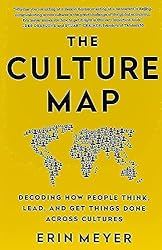
Rating: 7.7/10.
The Culture Map by Erin Meyer: Decoding How People Think, Lead, and Get Things Done Across Cultures
Book about how cultures differ across the world, categorizing differences among cultures along eight dimensions. Cultural differences can often lead to misunderstandings without either side realizing it. This is especially important in management where your words can have a lot of power, words can be misinterpreted and cause offense or embarrassment. We often don’t even realize our cultural biases exist since we’ve been used to them our whole lives, like a fish that doesn’t realize it lives in water. It’s only when we misunderstand another culture that these differences become obvious. While there are individual variations, there’s always a range of behaviors acceptable in any culture, and this range may be totally different in another culture.
For instance, one example was an American speaker working with a Chinese man during a joint presentation. The American was waiting for the Chinese individual to share his opinions, but the Chinese man was waiting for the American to stop talking and invite him to speak. In another example, a French manager, who recently started working in the US, wasn’t accustomed to the American style of providing some praise before negative feedback. She didn’t even notice her superior was giving her negative feedback, and when giving feedback to her reports, she greatly offended many of them.
The first difference is high versus low context. In high context cultures (eg: China, Japan, India) things tend to be more implicit, whereas low context cultures (eg: Americans) state everything explicitly, sometimes multiple times. High context cultures are common among people who have a shared cultural heritage, having developed a system to communicate subtly; this explains why Americans, with lots of immigrants, developed a low context system. A person from a low context culture might perceive a high context person as secretive, whereas the high context individual might see the low context person as stating the obvious and repeating it. In a multicultural team, it’s crucial to operate in a low context manner because high context cultures from different regions might misunderstand each other.
Next is how different cultures give and receive negative feedback: direct or indirect. The Dutch are very direct and can give negative feedback bluntly, even in front of the whole team. Americans, even though they are generally clear communicators, tend to downplay negative feedback and mix it with the positive. In indirect cultures, you should never give feedback in front of a group and should be more subtle, like mentioning the positives and communicating negative points by neglecting to mention them as positives. Still, don’t try to mimic the direct feedback of the Dutch because you may still overstep and be offensive.
Communicating an argument: cultures can be either applications-first or principles-first. Americans are applications-first, so they are convinced by case studies and examples, and like to get to the high-level point quickly. In contrast, Europeans are principles-first, so they like to build up a chain of reasoning before arriving at a conclusion at the end. Asian cultures think more holistically, preferring to look at the whole picture instead of focusing on specific points one at a time, and they worry that Americans will miss the indirect systemic effects of any action.
Egalitarian vs hierarchical cultures. In hierarchical cultures (eg: East Asia and Latin America), subordinates are expected to obey the boss, and the boss is expected to act like one, having all the answers and providing specific details about everything. In contrast, in egalitarian cultures, it can be challenging to identify who the boss is in a room. In hierarchical cultures, it’s offensive to bypass the boss in communications, viewing it as an act of betrayal. However, this is entirely normal in egalitarian cultures. Within the hierarchy, the boss shouldn’t be challenged, even if he or she is wrong.
Decision making: Americans are very hierarchical — the leader sets a direction, and everyone follows; they prefer to decide quickly and leave it amendable for change later. In contrast, Nordic countries aim for consensus, and once a decision is made, it’s final. The Japanese use hierarchical yet consensus-based decision mechanisms, where subordinates discuss among themselves, reach a conclusion, and then present it to the manager.
Relationship-based cultures (eg: Europeans and Arabs) prefer to build trust before getting down to business. It’s expected to have long lunches and dinners and get drunk with clients and coworkers, and it’s expected to let one’s guard down. Americans are task-focused and jump straight into business, often not having friendly relationships with coworkers outside of work. Relationship-based cultures find it rude to start doing business without first building trust, and will often ignore cold emails from strangers.
Handling disagreement: cultures vary in how much they like open confrontation. Europeans think it’s typical and healthy to debate, distinguishing between debating a position and attacking a person. Meanwhile, East Asians avoid open disagreements, and for these avoidance cultures, direct disagreements can hurt relationships.
Time management: linear-time cultures like Germany and Japan prefer things to start and end precisely on time, with plans made well in advance. Latin and African cultures like a more flexible approach to time, where a starting time is only a rough guideline, and meetings can start late or run over without anyone taking offense. Flexible time cultures correlate with unpredictable environments, while fixed-time cultures often industrialized earlier, requiring an efficient, fixed schedule. Flexible-time cultures also tend to value relationship-building because they come from systems where trust is crucial for business, and there is a weak legal system.
This book provides a good overview of how cultures differ along several dimensions. It focuses cultural differences relevant to business settings and professional communications, especially between a manager and their subordinates, so it is relevant for cross-cultural teams and outsourcing work to other parts of the world. It’s interesting to see how different cultures can be similar in some aspects but very different in others: even countries close together in the same region can differ in certain cultural aspects. Some areas could be improved in this book: there are many other cultural differences that are not in scope, like relationships outside of work (family dynamics, and gender roles across cultures). The author also isn’t clear about the data presented (ranking countries on a scale for each of these dimensions); it’s unclear whether it’s just the author’s gut feeling or actually based on survey data.



